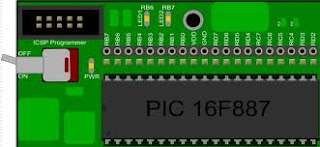PIC16F877 IC
PIC16F877 pin layout
SK40C Development Board
SK40C and PIC16F877
INTRODUCTION
This tutorial is to introduce the using of Microcontroller Microchip PIC16F877, its technolgy the capabilities and
the specifications of a commonly used in market and
describe the experiments conducted using the SK40C development board from Cytron Technology which accomodates this microcontroller .
A microcontroller is a compact
standalone mini-computer, optimized for control applications. Entire processor,
memory and the I/O interfaces are located on a single piece of silicon so, it
takes less time to read and write to extrernal devices.
The reasons why
microcontrollers are incorporated in control systems are:
1) Cost: Microcontrollers with the supplemantary circuit
components are much cheaper than a computer with an analog and digital I/O
2) Size and Weight: Microcontrollers are compact and light
compared to computers
3) Simple applications: If the application requires very few
number of I/O and the code is relatively small, which do not require extended
amount of memory and a simple LCD display is sufficient as a user interface, a
microcontroller would be suitable for this application.
4) Reliability: Since the architecture is much simpler than
a computer it is less likely to fail.
5) Speed: All the
components on the microcontroller are located on a singe piece of silicon.
Hence, the applications run much faster than it does on a computer.
One of the most important feature of the microcontroller is a number of input/output pins used for connection with peripherals. In this case, there are in total of thirty-five general purpose I/O pins available, which is quite enough for the most applications. In order pins’ operation can match internal 8-bit organization, all of them are, similar to registers, grouped into five so called ports denoted by A, B, C, D and E. They all have several features in common:
To become familiar how to start your first program click here
All programs written in C langguage.
To see a lot of projects done click here
In my next tutorial you will learn about basic language i.e Pic Basic Pro (PBP). It is more easier than using C language, but the programming architechture is almost the same. However, for those who are expert, some programming features in PBP are so limited, thus C langguage is most suitable. For beginners, PBP is the best choice and more prefereable. If you are good enough to master PBP, a lot of things can be done.










